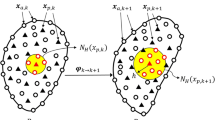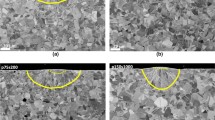Abstract
Laser additive manufacturing has been regarded as a typical green manufacturing process. This paper presents a novel numerical approach termed time step fusion (TSF) along with the finite volume method (FVM), for fast computing the temperature field in a predominant laser additive manufacturing process, namely, selective laser melting. The solution acceleration strategy using TSF is that the entire computational domain is partitioned into multiple subdomains, and in the subdomain distant from the laser source and with the milder thermal gradients, larger time steps are employed. A thin wall is simulated to verify the proposed TSF method and evaluate its effectiveness and efficiency. The results are compared with those of the standard FVM model without TSF. It shows that they are in good agreement in terms of the spatiotemporal thermal profiles. The mean absolute error for the case studies with TSF is below 1 K except for a few spikes of the discrepancy reaching up to 15 K in the molten pool. Meanwhile, up to 28% acceleration in computational speed is obtained with TSF-FVM compared with regular FVM, and 93% time saving is achieved compared with a benchmark FEM model with a commercial solver. An extended case study is also presented to further verify the applicability of the proposed approach for complex geometries. The factors that contribute to the speed are analyzed, and the strategies for potential further improvement are also discussed.















Similar content being viewed by others
References
Ahn DG (2016) Direct metal additive manufacturing processes and their sustainable applications for green technology: a review. Int J Precis Eng Manuf-Green Technol 3(4):381–395
Tebaay LM, Hahn M, Tekkaya AE (2020) Distortion and dilution behavior for laser metal deposition onto thin sheet metals. Int J Precis Eng Manuf-Green Technol. https://doi.org/10.1007/s40684-020-00203-9
Li C, Fu CH, Guo YB, Fang FZ (2015) Fast prediction and validation of part distortion in selective laser melting. Procedia Manuf 1:355–365
Li J, Jin R, Yu HZ (2018) Integration of physically-based and data-driven approaches for thermal field prediction in additive manufacturing. Mater Des 139:473–485
Keller N, Ploshikhin V (2014) New method for fast predictions of residual stress and distortion of AM parts. In: Solid freeform fabrication symposium (SFF), Austin, TX, Aug, pp. 4–6
Pal D, Patil N, Zeng K, Stucker B (2014) An integrated approach to additive manufacturing simulations using physics based, coupled multiscale process modeling. J Manuf Sci Eng 136(6):061022
Konstantinou I, Vosniakos GC (2016) Rough-cut fast numerical investigation of temperature fields in selective laser sintering/melting. Int J Adv Manuf Technol 99(1–4):29–36
Denlinger ER, Gouge M, Irwin J, Pan M (2017) Thermomechanical model development and in situ experimental validation of the laser powder-bed fusion process. Additive Manuf 16:73–80
Zeng K, Pal D, Gong HJ, Patil N, Stucker B (2015) Comparison of 3DSIM thermal modelling of selective laser melting using new dynamic meshing method to ANSYS. Mater Sci Technol 31(8):945–956
Hajializadeh F, Ince A (2019) Finite element–based numerical modeling framework for additive manufacturing process. Mater Des Process Commun 1(1):e28
Zhang J, Chauhan S (2019) Fast explicit dynamics finite element algorithm for transient heat transfer. Int J Therm Sci 139:160–175
Stathatos E, Vosniakos G-C (2018) A computationally efficient universal platform for thermal numerical modeling of laser-based additive manufacturing. Proc Inst Mech Eng Part C J Mech Eng Sci 32(13):2317–2333
Favoretto B, De Hillerin CA, Bettinotti O, Oancea V, Barbarulo A (2019) Reduced order modeling via pgd for highly transient thermal evolutions in additive manufacturing. Comput Methods Appl Mech Eng 349:405–430
Chiumenti M, Neiva E, Salsi E, Cervera M, Badia S, Moya J, Davies C (2017) Numerical modelling and experimental validation in Selective Laser Melting. Additive manuf 18:171–185
Michaleris P (2014) Modeling metal deposition in heat transfer analyses of additive manufacturing processes. Finite Elem Anal Des 86:51–60
Patil N, Pal D, Stucker B (2013) A new finite element solver using numerical eigen modes for fast simulation of additive manufacturing processes. In: Proceedings of the solid freeform fabrication symposium, Austin, TX, Aug, pp. 12–14
Ding J, Colegrove P, Mehnen J, Williams S, Wang F, Almeida PS (2014) A computationally efficient finite element model of wire and arc additive manufacture. Int J Adv Manuf Technol 70(1–4):227–236
Mirkoohi E, Ning J, Bocchini P, Fergani O, Chiang KN, Liang S (2018) Thermal modeling of temperature distribution in metal additive manufacturing considering effects of build layers, latent heat, and temperature-sensitivity of material properties. J Manuf Mater Process 2(3):63
Ning J, Sievers DE, Garmestani H, Liang SY (2019) Analytical modeling of in-process temperature in powder bed additive manufacturing considering laser power absorption, latent heat, scanning strategy, and powder packing. Materials 12(5):808
Ning J, Sievers DE, Garmestani H, Liang SY (2019) Analytical modeling of in-process temperature in powder feed metal additive manufacturing considering heat transfer boundary condition. Int J Precis Eng Manuf-Green Technol. https://doi.org/10.1007/s40684-019-00164-8
Steuben JC, Birnbaum AJ, Michopoulos JG, Iliopoulos AP (2019) Enriched analytical solutions for additive manufacturing modeling and simulation. Additive Manuf 25:437–447
De La Batut B, Fergani O, Brotan V, Bambach M, El Mansouri M (2017) Analytical and numerical temperature prediction in direct metal deposition of Ti6Al4V. J Manuf Mater Process 1(1):3
Peyre P, Aubry P, Fabbro R, Neveu R, Longuet A (2008) Analytical and numerical modelling of the direct metal deposition laser process. J Phys D Appl Phys 41(2):025403
Mozaffar M, Ndip-Agbor E, Lin S, Wagner GJ, Ehmann K, Cao J (2019) Acceleration strategies for explicit finite element analysis of metal powder-based additive manufacturing processes using graphical processing units. Comput Mech 64:879–894
Foteinopoulos P, Papacharalampopoulos A, Stavropoulos P (2018) On thermal modeling of additive manufacturing processes. CIRP J Manuf Sci Technol 20:66–83
Peng H, Ghasri-Khouzani M, Gong S, Attardo R, Ostiguy P et al (2018) Fast prediction of thermal distortion in metal powder bed fusion additive manufacturing: Part 1, A thermal circuit network model. Additive Manuf 22:852–868
Lee H, Lim CHJ, Low MJ, Tham N, Murukeshan VM, Kim YJ (2017) Lasers in additive manufacturing: a review. Int J Precis Eng Manuf-Green Technol 4(3):307–322
Bauereiß A, Scharowsky T, Körner C (2014) Defect generation and propagation mechanism during additive manufacturing by selective beam melting. J Mater Process Technol 214(11):2522–2528
Wei P, Wei Z, Chen Z, He Y, Du J (2017) Thermal behavior in single track during selective laser melting of AlSi10Mg powder. Appl Phys A 123(9):604
Bruna-rosso C, Demir AG, Previtali B (2018) Selective laser melting finite element modeling: validation with high-speed imaging and lack of fusion defects prediction. Mater Des 156:143–153
Goldak J, Chakravarti A, Bibby M (1984) A new finite element model for welding heat sources. Metall Trans B 15(2):299–305
Lindgren LE, Michaleris P (2005) Modeling of welding for residual stresses. Handbook on residual stress, vol 2, SEM, USA, pp 47-67
Shen N, Chou K (2012) Thermal modeling of electron beam additive manufacturing process: Powder sintering effects. ASME 2012 international manufacturing science and engineering, Notre Dame, Indiana, USA, June 4–8, pp 287–295
Versteeg HK, Malalasekera W (2007) An introduction to computational fluid dynamics—the finite volume method, 2nd edn. Pearson Education, Upper Saddle River
Mezzetta J, Choi JP, Milligan J, Danovitch J, Chekir N, Bois-Brochu A, Brochu M (2018) Microstructure-properties relationships of Ti-6Al-4V parts fabricated by selective laser melting. Int J Precis Eng Manuf-Green Technol 5(5):605–612
Ma C, Vadali M, Duffie NA, Pfefferkorn FE, Li X (2013) Melt pool flow and surface evolution during pulsed laser micro polishing of Ti6Al4V. J Manuf Sci Eng 135(6):061023
Wang J, Shi J, Wang Y, Hu Y, Dai J, Xu K (2018) Fast computation of thermal field of direct metal deposition: A preliminary study based on quiet element method. ASME 2018 international manufacturing science and engineering conference, vol 4: Processes: V004T03A045. College Station, Texas, USA, June 18–22
Chen Z, Guo X, Shi J (2020) Hardness prediction and verification based on key temperature features during the directed energy deposition process. Int J Precis Eng Manuf-Green Technol. https://doi.org/10.1007/s40684-020-00208-4
Yuan C, Wang T, Dunn ML, Qi HJ (2017) 3D printed active origami with complicated folding patterns. Int J Precis Eng Manuf-Green Technol 4(3):281–289
Acknowledgements
The authors wish to acknowledge the funding support from the National Science Foundation (Award number NSF#1563002).
Author information
Authors and Affiliations
Corresponding author
Ethics declarations
Conflict of interest
The authors have no competing interests to declare.
Additional information
Publisher's Note
Springer Nature remains neutral with regard to jurisdictional claims in published maps and institutional affiliations.
Rights and permissions
About this article
Cite this article
Wang, J., Wang, Y. & Shi, J. A Novel Time Step Fusion Method with Finite Volume Formulation for Accelerated Thermal Analysis of Laser Additive Manufacturing. Int. J. of Precis. Eng. and Manuf.-Green Tech. 8, 1181–1196 (2021). https://doi.org/10.1007/s40684-020-00237-z
Received:
Revised:
Accepted:
Published:
Issue Date:
DOI: https://doi.org/10.1007/s40684-020-00237-z




